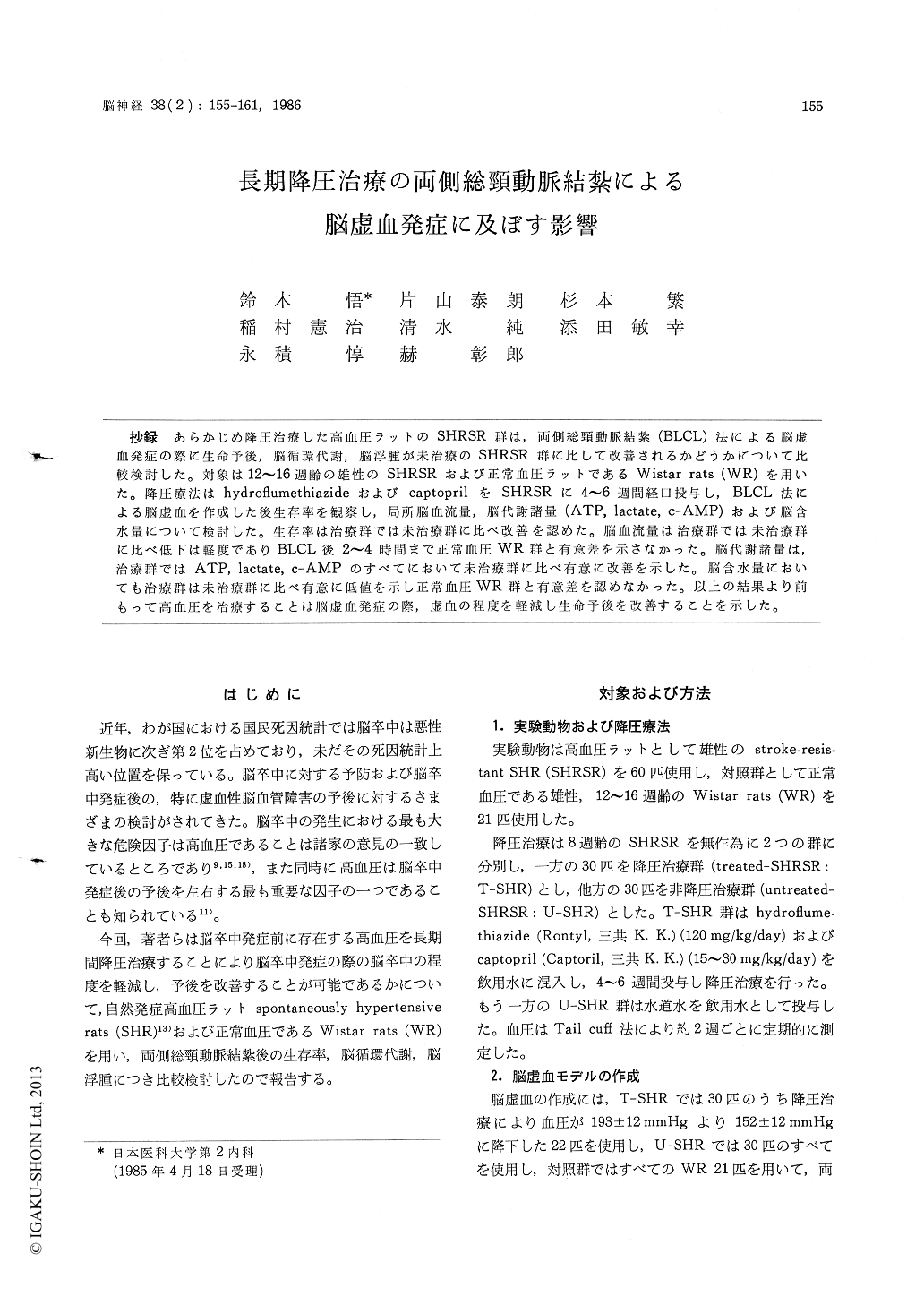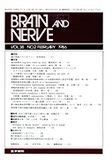Japanese
English
- 有料閲覧
- Abstract 文献概要
- 1ページ目 Look Inside
抄録 あらかじめ降圧治療した高血圧ラットのSHRSR群は,両側総頸動脈結紮(BLCL)法による脳虚血発症の際に生命予後,脳循環代謝,脳浮腫が未治療のSHRSR群に比して改善されるかどうかについて比較検討した。対象は12〜16週齢の雄性のSHRSRおよび正常血圧ラットであるWistar rats (WR)を用いた。降圧療法はhydroflumethiazideおよびcaptoprilをSHRSRに4〜6週間経口投与し,BLCL法による脳虚血を作成した後生存率を観察し,局所脳血流量,脳代謝諸量(ATP, lactate, c-AMP)および脳含水量について検討した。生存率は治療群では未治療群に比べ改善を認めた。脳血流量は治療群では未治療群に比べ低下は軽度でありBLCL後2〜4時間まで正常血圧WR群と有意差を示さなかった。脳代謝諸量は,治療群ではATP,lactate, c-AMPのすべてにおいて未治療群に比べ有意に改善を示した。脳含水量においても治療群は未治療群に比べ有意に低値を示し正常血圧WR群と有意差を認めなかった。以上の結果より前もって高血圧を治療することは脳虚血発症の際,虚血の程度を軽減し生命予後を改善することを示した。
The susceptibility to cerebral ischemia was stu-died in stroke-resistant spontaneously hypertensive rats (SHRSR) treated by a long-term antihyperten-sive treatment, and compared with untreatedSHRSR and Wistar rats (WR).
Male SHRSR, aged 8 weeks, were divided into two groups and a long-term antihypertensive treatment for 4-6 weeks was started on one group (treated SHRSR: T-SHR) while the other group was left untreated as control (untreated SHRSR : U-SHR). The changes of blood pressure were checked on these rats. The prior treatment of hypertension was achieved by administration of hydroflumethiazide (120 mg/kg/day) and captopril (15-30 mg/kg/day) orally for 4-6 weeks by mixing in drinking water. All the experiments were performed at the age of 12-16 weeks and WR of similar age served as normotensive untreated control. Cerebral ischemia was induced by bilateral common carotid artery ligation (BLCL) and blood pressure was always checked before BLCL. The survival ratio was observed from 1 hour to 24 hours after BLCL. The regional cerebral blood flow (rCBF) were mea-sured before and 4 hours after BLCL periodi-cally. The brain energy metabolites were measured 4 hours after BLCL. rCBF were measured at the thalamus by the hydrogen clearance method. ATP concentrations were determined by luciferine-luciferase method, c-AMP was measured by RIA and lactate by enzymatic method. The brain water content was measured by freeze-dry method. The initial average blood pressure of T-SHR was 214+11 mmHg at 8 weeks old and gradually fell to 166±12 mmHg at the time of experiment after 4-6 weeks of treatment. On the other hand, the initial blood pressure of U-SHR was 202±10 mmHg at 8 weeks old and slightly elevated to 212±16 mmHg at the time of experiment after 4-6 weeks. The average blood pressure of WR, aged 12-16 weeks, was 132±12 mmHg at the time of experiment.
The survival ratio in T-SHR was higher than that of U-SHR. Especially, at 7 hours after BLCL,the ratio was 57.1% in T-SHR and 25.0% in U-SHR, while WR showed a high survival ratio of 71.4%. WR remained to show the high survival ratio untill 24 hours after BLCL. The rCBF of three groups were identical before BLCL. The rCBF of T-SHR was 44.0% of control after 2 hours of BLCL. and was statistically higher than U-SHR till 4 hours of BLCL. The rCBF of T-SHR after 4 hours of BLCL showed the similar level as much as observed in WR. In measurements of brain energy metabolites after BLCL, the concent-rations of ATP and c-AMP in T-SHR were sta-tistically higher than U-SHR, and lactate level in T-SHR was significantly lower than U-SHR. The brain water content after BLCI, was 78.42% in T-SHR, while 79.57% in U-SHR, and 78.24% in WE. The brain water content in T-SHR was statistically lower than in U-SHR and was not significant compared with WE.
These results indicate that prevalence of ische-mic symptoms are most prevailed in the hyperten-sive untreated SHR compared with treated SHE or normotensive WR, and a certain amelioration of ischemic symptoms were observed in treated SHR.
There were severe impairment of CBF and metabolism and aggravation of brain edema in ex-istance of persistent hypertension. It is shown that a long-term antihypertensive treatment reduces the ischemic symptoms and susceptibility to ische-mia by the mechanisms which is yet not fully understood, which may involve lowering of vas-cular resistance, improvement of collateral circula-tion, and amelioration of secondary circulatory disturbances induced by brain edema etc..
Therefore, the treatment of persistent hyperten-sion not only reduces the incidence of ischemic stroke but also ameliorates the degree of ischemia and contributes for better survival and prognosis.

Copyright © 1986, Igaku-Shoin Ltd. All rights reserved.


